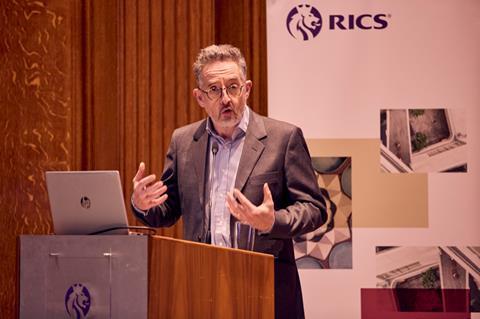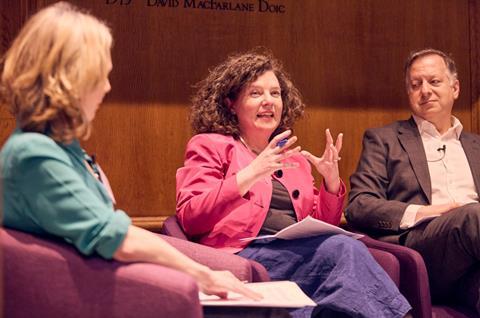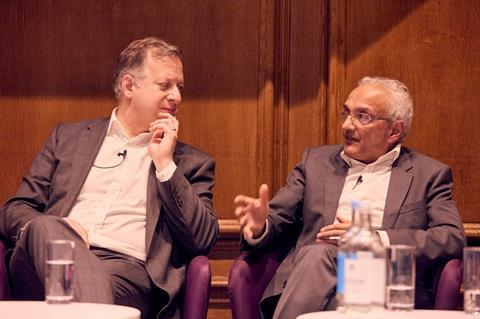Former RIBA president Sunand Prasad and Save Britain’s Heritage director Henrietta Billings among Industry experts which discussed how much weight should be given to retrofit schemes by the planners and regulators. Tom Lowe reports

Should development in the UK be regulated on the principle of “retrofit first” or “retrofit only”? This was the question discussed at a Royal Institution of Chartered Surveyors (RICS) panel debate last week.
It could not have been better timed – one of the biggest planning stories of last year, Michael Gove’s rejection of Marks & Spencer’s plans to demolish and rebuild its Oxford Street store was about to be overturned. Just two days after the debate, the High Court quashed Gove’s decision, reopening questions around how the planning system should handle demolition schemes and to what degree retrofit should be prioritised.
On the panel for the RICS debate was Henrietta Billings, director of Save Britain’s Heritage, the campaign group which had led the case against M&S’ proposals at the 2022 public inquiry. She was joined by Mike Hussey, chief executive of developer Almacantar and former managing director of Landsec, Sunand Prasad, principal at Perkins & Will, chair of the UK Green Building Council and past president of RIBA, Olaide Oboh, executive director of mixed-use developer Socius and Basil Demeroutis, managing partner at Fore Partnership. The panel was chaired by Chloe McCulloch, editor of Building Design’s sister title Building.
The past, the future, the present of locations in London, Manchester, Stoke on Trent, Digbeth, would be different if we had to go down that retrofit route only
Simon Rawlinson, Arcadis
Simon Rawlinson, head of strategic research and insight at Arcadis and chair of RICS’ knowledge and practice committee, kicked off proceedings with a keynote speech. He started by using the area around Fenchurch Street as an example of a retrofit “petri dish”.
In this rather “dowdy and down-at-heel” corner of the City of London, Rawlinson said, there are buildings that are worth saving, buildings that could be improved and some buildings that are not worth saving at all. Moreover, it is a place where development is going to happen “at scale”, either at existing buildings which have preservation value or at sites which have massive value in the air above them but no value in the buildings themselves.

“That, for me, is part of the debate about the retrofit,” Rawlinson said. “It’s not about the building itself… it’s the potential value not just to the developer but to wider society itself. And I’m going to say that the past, the future, the present of Fenchurch Street – and many other locations like that, not just in London, but elsewhere in Manchester, Stoke on Trent, Digbeth – would be different if we had to go down that retrofit route only.”
Is it old fashioned 20th century thinking to think we have a disposable built heritage that we can knock down at will?
Henrietta Billings, Save Britain’s Heritage
Rawlinson posed the panel three questions. First, he asked them to think about a decade of recent architectural history and what things would not have happened if there had been a retrofit only policy at that time. “What things would we have missed out on? What things might not have happened?”
Secondly, he asked the panel to think about all the things they would like to do in the future, and what they could do without taking the “extreme measure” of banning new-build. Thirdly, he asked what a value test for embodied carbon and retrofit could look like.
First to speak was Billings, who began by highlighting the significance of the public inquiry into the M&S scheme and the national attention it generated. “It came at a time when there was an increasing awareness about the climate crisis, about how we are knocking down perfectly structurally-sound buildings and chucking them away,” she said.

“The question now about it really is how do we use the resources that we’ve got? How do we make sure that we are responsible as we go forward in the 21st century? Is it old-fashioned 20th-century thinking to think we have a disposable built heritage that we can knock down at will?”
> Also read: What does the High Court’s ruling mean for M&S’s Oxford Street plans? Lawyers give their views
> Also read: To retain or rebuild? M&S case shows the industry needs rules
Billings was keen to stress that she was “certainly not an extremist” on retrofit, and the most important measure of progress for the development sector was to find a consensus. She argued in favour of a system of mandatory whole-life carbon assessments, but where developers are “earning the commutes” of their tenants.
“Providing buildings of character which are sustainable and socially responsible, moving away from brand new steel blocks to repurposing buildings with character and interest and buildings that tell a story.”
We’re living outside of the boundaries of what this planet can sustain, and at some point we’re going to run out
Basil Demeroutis, Fore Partnership
Demeroutis took a more hardline view. Fore Partnership builds mostly commercial space and has developed projects in the City, and is currently on site next to Tower Bridge. But Demeroutis said the firm has pushed its strategy so far towards retrofit that it is now “unlikely to do much more, if any new development”.
Explaining this, he said that 100 billion tonnes of materials – a quantity about two-thirds the size of Mount Everest – are mined out of the earth each year, around half of this going into the built environment, and around a third of this half being thrown away during redevelopments.
“I think we’re going to look back at this period of time – and our descendants will look back at this – as a barbaric period of human history,” he said. “We’re living outside of the boundaries of what this planet can sustain, and at some point we’re going to run out.”
He added: “Before we really jump into deciding what we’re going to build, we have to really take stock of what we have and think quite seriously about whether we could do something with it. And I think when we don’t really do that work seriously and sincerely and with some integrity, we’re doing a disservice to those who come after us.”

Prasad described himself as “definitely a believer, just not a fundamentalist”. He gave examples of several emerging tools that developers can use to “take the emotion” out of decisions on retrofit or new-build, including the RICS’ whole-life carbon assessment. But he said the real problem is that retrofit is still underrated.
“It’s not fashionable, it’s not taught in architecture schools, it’s not what every architect wants to put on the wall. And yet I think it is one of the most exciting things, that requires the greatest imagination.”
Retrofit is not fashionable, it’s not taught in architecture schools, … and yet I think it is one of the most exciting things
Sunand Prasad, Perkins & Will
No one at the debate would stand up and argue for a retrofit-only planning system, Prasad said, and this lobby is actually very small. He argued that, in the context of the climate emergency, there should be a presumption that buildings are retained and retrofitted rather than replaced. Most developers will include a retention option as part of their proposals for a scheme, and Prasad said it would not be a big step to introduce a greater weight for these options.
> Also read: Westminster council unveils plans to become a ‘retrofit-first’ city
Oboh brought the debate back to Rawlinson’s point about the social value of retrofitting existing buildings. Her firm, Socius, has started to take a retrofit-first approach after an experience on a project in Brighton a few years ago. Oboh had been met with a “real uprising” from locals who wanted to save a building that, despite not being particularly beautiful, was still valued by the community.
“Actually what local people value and what they appreciate, what they have walked past for many years and they’ve got memories and experiences in those spaces, that is something that we have to learn to understand,” she said.

Working on reuse projects is still a continuous challenge to balance viability, planning and finding the right skills, Oboh admitted, and she stressed the need for clarity in planning policy so that both sides knew the direction of travel, something that is not currently the case. But she said she had seen a “real change” in public sentiment towards retrofit projects.
“For us, it’s that creative and imaginative approach to how we repurpose buildings, to give them a new lease of life, is something we are fascinated and equally excited about.” For Socius, the question is how to focus on retrofit while also making sure the debate is nuanced: “We can’t save everything, but we need to try.”
That creative and imaginative approach to how we repurpose buildings to give them a new lease of life is something we are fascinated and equally excited about
Olaide Oboh, Socius
For Hussey, the most important factor for developers in the debate for and against prioritising retrofit was policy consistency. Hussey is a big player in the property sector, having built around 25 million square feet of mixed-use space in central London and Canary Wharf, a fifth of that being refurbishments.
His experience of the politicians who have shaped planning policy is that they are “genuinely useless”. “They work on a five-year programme, typically to get re-elected… and they have a very biassed agenda. But we’re working on 10, 20, 30, 40-year programmes.”

Hussey’s key point was to ask about the long term priorities of communities affected by buildings, and what are the policies that can be sustained for longer than five years. “The problem with fiddling and messing around the edges is if you can’t finance it, you can’t build it, you then take longer to generate the growth that supports the increasing population in the world, and everybody suffers. So I think we need to educate the system first, and we need to invest in the system.”
If you can’t finance it, you can’t build it. You then take longer to generate the growth that supports the increasing population in the world, and everybody suffers
Mike Hussey, Almacantar
But the debate over retrofit, Hussey argued, was a “one-dimensional question with a multi-dimensional answer”. In essence, he said it was about market demand. The development of Canary Wharf in the 1980s and 1990s had been supported by most locals, he said, because it had brought jobs to the area and supported communities.
“If it suddenly becomes more important that we protect the planet – and it is incredibly important – then other things have to give, if you’re not going to be creating growth and developing more viable schemes with greater profits and therefore recycling capital back into the community.”
The “Retro-fit first vs Retro-fit only”debate was the third in a series of events in the RICS Great Hall, in central London. Building was the event’s media partner













No comments yet